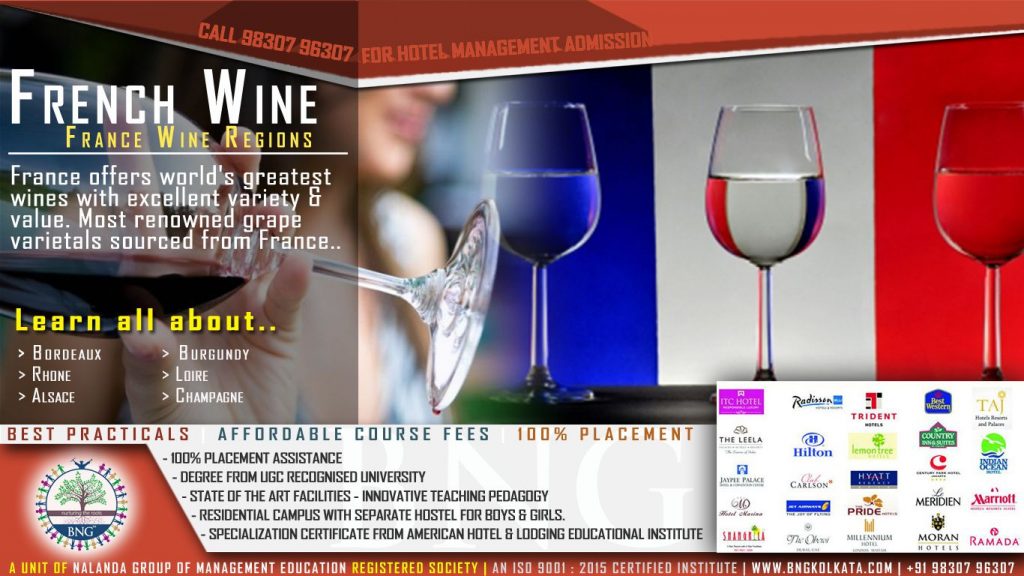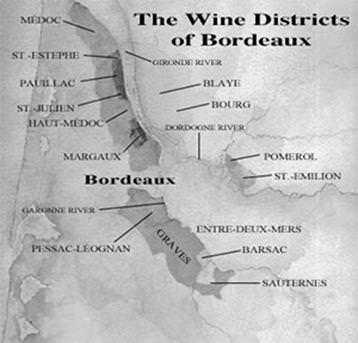Wine – French Wines for Hospitality and Tourism
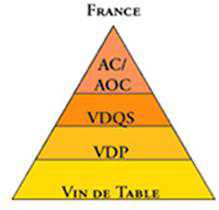 French wines can be complicated but at Wine & Beyond, we strive to make shopping French wines easy and exciting. France offers some of the world’s greatest wines with excellent variety and value. Most of the entire renowned grape varietals available today were sourced from France from Cabernet Sauvignon to Sauvignon Blanc.
French wines can be complicated but at Wine & Beyond, we strive to make shopping French wines easy and exciting. France offers some of the world’s greatest wines with excellent variety and value. Most of the entire renowned grape varietals available today were sourced from France from Cabernet Sauvignon to Sauvignon Blanc.
All French wines are classified and labelled according to the “Appellation d’Origine Controlee” system or “AOC” for short. This system ensures authenticity and that the grapes are grown in the area stated on the label. Usually, the smaller the place where a wine is named from, the higher it’s rank. This pyramid has the levels from highest quality (top) to the lowest.
In France, wines are typically named after the vineyard or growing region where they were produced instead of the grape varietals.
Explore French Wines
French Wines Name (Region) |
Grape Varieties |
|
|
France has five main regions which are Bordeaux, Burgundy and the Rhone for red french wines
while whites are Burgundy, Loire and Alsace.
Bordeaux
A wine region in Southwestern France, where most of the french wines are dry red that has the reputation as being one of the greatest french wine regions in the world. These wines can range from everyday table wine to the most prestigious, called first growths (Premier Crus). Bordeaux is known for the following Premier Crus:
Château Haut-Brion
Château Lafite Rothschild
Château Latour
Château Margaux
Château Mouton-Rothschild
Basically, Bordeaux’s wine regions can be broken into three sub-regions:
- Left Bank (Cabernet & Sauvignon Blends dominate)– includes Medoc, Haut-Medoc and Graves. The wines have aromas of cherry, black currants with spice and cedar notes. They display firm tannins that mellow out over time. Bordeaux also produce dry white wines and sweet white wines (from Sauternes) blended from Semillon and Sauvignon Blanc.
- Right Bank (Merlot dominated blends) – famous for Pomerol and St. Emilion. These reds have rich, smooth tannins and complex red berry fruit aromas, developing tobacco and cedar nuances as they evolve.
- Entre-Deux-Mers – known for large production, value blends like Red Bordeaux – usually a blend of grapes including Cabernet Sauvignon, Cabernet France, Merlot and Petit Verdot .
The red wines of Bordeaux are a blend of red grape varieties with the majority being Cabernet Sauvignon and Merlot. The other varietals include Cabernet Franc, Petit Verdot and Malbec.
 Burgundy
Burgundy
Most french wines are made from Chardonnay, Pinot Noir or Gamay grapes in one of the three main regions of Burgundy:
Chablis (Chardonnay) – Northern part of Burgundy that produces crisp, high acid, dry Chardonnay with apple, and citrus fruit aromas and flavors with a hint of minerality. The best are called Grand Cru.
Cote d’Or (Pinot Noir) – Heart of Burgundy that produces mostly red wines from Pinot Noir grapes. These french wines offer aromas and flavors of berries, cherries and earth, having the reputation of producing the greatest Pinot Noir’s in the world. The best are called Grand Cru.
Chalon, Macon and Beaujolais – Warmer, Southern end that make french wines with raspberry and cherry aromas and flavors. Beaujolais are light, easy drinking reds made from Gamay grapes. The best are the ten village crus.
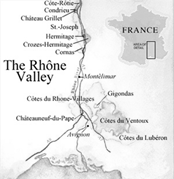 Rhone
Rhone
The Rhone valley is situated in southern France and is famous for hearty, spicy reds, aromatic whites and dry roses.
- Northern Rhone (Syrah)
- Cote-Rotie (Syrah)
- Condrieu (Viognier)
- Hermitage (Syrah)
Loire

The Loire Valley offers single variety french wines from Sauvignon Blanc and Cabernet Franc grapes. These french wines are crisp, refreshing and great pairings with food. The Valley is broken into four areas (moving from east to west):
- Central Vineyards (Sauvignon Blanc) – the villages here, Sancerre and Pouilly-Fume specialize in white wines made from Sauvignon Blanc. Sancerre is light-bodied with herb and mineral aromas and flavors while Pouilly-Fume is fuller and fruitier .
- Touraine & Anjou-Saumur (Chenin Blan & Cabernet Franc) – the main white variety in these areas is Chenin Blanc while Cabernet Franc is the most important red grape in the region. Anjou makes light red and roses.
- Nantais (Muscadet): The french wines from this area are light to medium-bodied with fresh, crisp acidity and attractive green apple and grassy aromas and flavors. These wines are very food friendly and versatile.
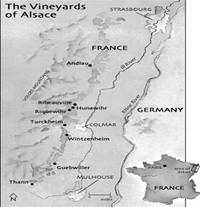
Alsace
Two of the most important varieties from Alsace are Riesling and Gewurztraminer which produce full-bodied and intensely flavored white wines. The Alsace Rieslings are full-bodied with flavors of citrus, peach, apple and pear. Gewurztraminer is extremely aromatic with aromas & flavors of spice, citrus, rose petals, apricot and lychee.
Dessert wines are also produced in Alsace.
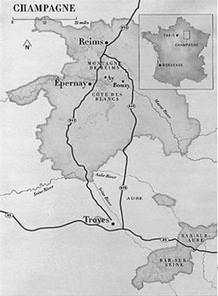
Champagne
We generally call sparkling wines Champagne; however, only sparkling wines grown in the region of Champagne, France are allowed to be called “Champagne.” The majority of Champagnes are blended from Chardonnay, Pinot Noir and Pinot Meunier.
The different types of Champagne include:
Non Vintage – french wines blends from different vintages.
Vintage – french wines from a single year.
Blanc de blancs – uses only Chardonnay grapes, very crisp and light bodied, with fresh citrus and apple fruit aromas and flavors.
Blanc de noirs – a white wine made from red-skinned Pinot Noir or Petit Meunier grapes. These wines tend to be full-bodied with rich fruit flavors and a long finish.
How to read French Wines Labels
Annee – Year the grapes were harvested in.
Appellation – AOC defined area where the grapes were grown in.
Blanc – White Wine.
Blanc Sec – White Wine
Brut – Dry Wine.
Cave – Wine Cellar.
Centenaire – Produced from grapes grown on vines more than 100 years of age.
Chateau – Estate where the wine was produced.
Cooperative – Group or syndicate of local growers that pool or mix their grapes.
Cote – Slopes or hillsides.
Cru – A wine, chateau or vineyard that has been classified.
Cru Classe – Vineyard that has been classified.
Date – The date on the label signifies year the grapes were harvested.
Demi Sec – Medium dry white wine.
Domaine – Similar to chateau, a place where the wine was made.
Grand Cru – A higher level of classification. The term Grand Cru takes on different meanings, depending on the region or AOC law.
Grand Cru Classe en 1855 – Specific to Bordeaux showing the chateau was classified in the 1855 Medoc Classification.
Grand Vin – The best wine from a producer.
Millesime – The vintage the grapes were harvested in.
Mis en Bouteille – The wine was bottled at the chateau or domaine.
Negociant – The wine was bottled by the negociant and was probably produced from purchased grapes or wine.
Premier Cru – A wine of First Growth status.
Premier Grand Cru Classe – A wine of First Growth status.
Pruduit de France – The wine is a product of France.
Proprietaire – Owner of the chateau or vineyard.
Recoltes – A wine made from estate grown grapes that is usualy of high quality.
Rouge – Red wine.
Selection de Grains Nobles – Sweet wine
Vendange – Harvest.
Vieilles Vignes – Old Vines
Vigneron – The owner, grape grower or vineyard manager.
Vignoble – Vineyard
Vin – Wine.
Vin de Bourgogne – Wine from Burgundy
Year – The year on the label signifies year the grapes were grown and harvested.

